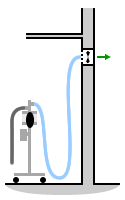|
Scavenging
of waste anesthetic gases
All operating
rooms and areas in which inhalation anesthesia is carried out should
be equipped with a scavenging system in order to reduce the exposure
of operating room personnel to waste anesthetic agents vented from
the breathing system.
Breathing
system outlet
Excess gas is
usually (except in the case of Mapleson E and F systems) vented
from the breathing system via an adjustable pressure-limiting (or
pop-off) valve.
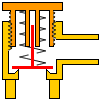
The valve disc
is held in place by a weak spring, the tension on which can be adjusted
by a screw machanism, thereby adjusting the pressure required to
open the valve.
The
outlet of the breathing system must be connected to the scavenging
system and not simply vented into the operating room. Modern adjustable
pressure relief valves incorporate a 19 mm outlet for this purpose:
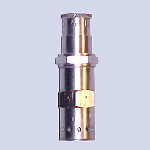 |
|
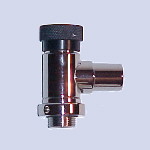 |
| Old
expiratory valve with no scavenging outlet. |
|
Modern
expiratory valve with 19 mm scavenging outlet. |
Types
of scavenging system
| Charcoal
canisters |
|
A canister
containing activated charcoal is connected to the outlet of
the breathing system and removes halogenated anesthetics by
filtration. It is replaced after every 12 hours of use.
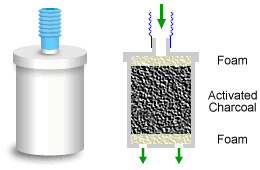
|
| Advantages |
| |
No
set-up cost
Mobile - moves with the machine |
| Disadvantages |
| |
Continuing
cost of replacement. The canisters can be refilled with fresh
charcoal, but this tends to be a rather messy undertaking
Does not remove nitrous oxide |
| Passive
systems |
| The
waste gases can be ducted out of the building via: |
| |
An open
window:

A pipe
passing though an outside wall:
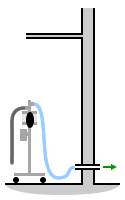
An extractor fan vented to the outside air (N.B. not
into the building's air-conditioning system)
|
| Advantages |
| |
Inexpensive
to set up
Simple to operate |
| Disadvantages |
| |
May
be impractical in some buildings |
| Active
systems |
|
These
systems connect the exhaust of the breathing system to
the Hospital vacuum system via an interface controlled
by a needle valve.
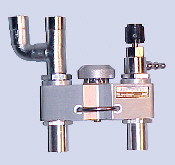 
The Ohio
scavenging interface has connections for the outlets from
the breathing system and ventilator (A), one or two reservoir
bags (B), and the vacuum line (V). The suction is controlled
by the needle valve (N). There are both positive (P1) and
negative (P2) pressure relief valves in case the reservoir
bag becomes empty or too full.
A home-built interface can
be constructed quite easily
and inexpensively from parts obtained at any hardware store:
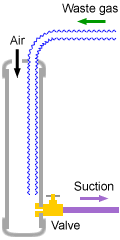
This consists
of a reservoir made of plastic pipe of around 3" in diameter
and 2 feet in length, capped at both ends and with a needle
valve fitted at the bottom. Two holes are drilled in the top
cap, one to allow the hose from the outlet of the anesthetic
machine to be inserted and the other to allow passage of atmospheric
air. The valve is adjusted so that air is slowly sucked into
the pipe when the anesthetic machine is in use: this will
prevent waste gases escaping into the atmosphere.
|
| Advantages |
| |
Convenient
in large hospitals where many machines are in use in different
locations |
| Disadvantages |
| |
Vacuum
system and pipework is a major expense
Needle
valve may need continual adjustment
|
|







